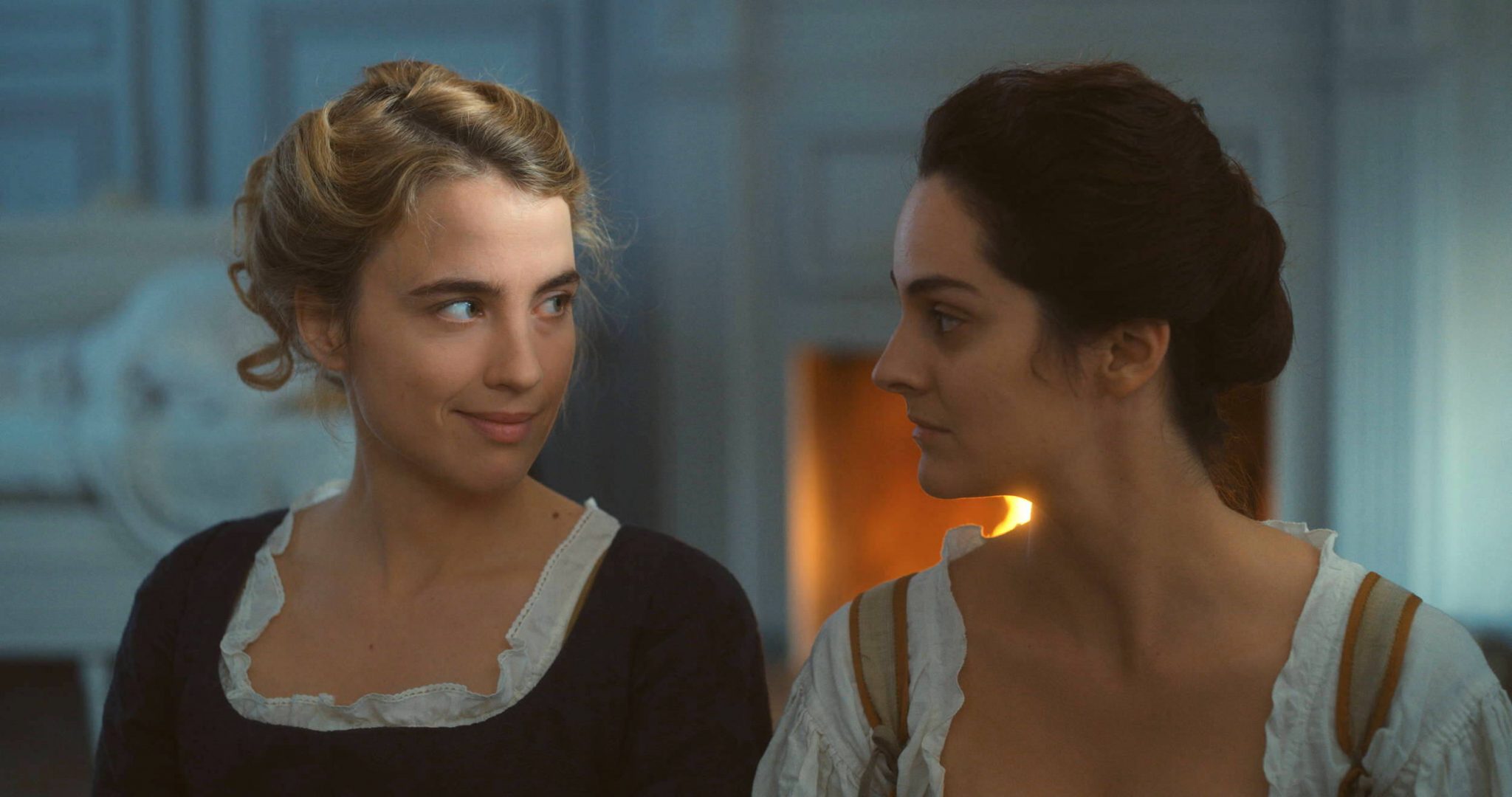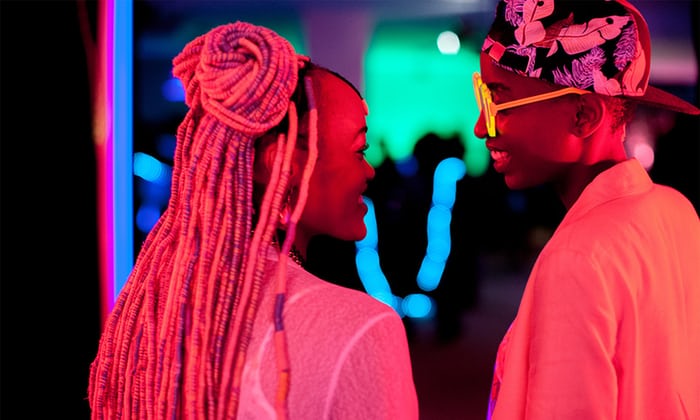“It’s time for lesbian love stories that aren’t white period dramas”

Love comes in many different forms, but when it comes to LGBTQ+ representation in Hollywood, there’s a predictable theme. Here, Christobel Hastings explores the reasons behind the prevalence of white period dramas about lesbian relationships, and the stories shifting the way queer women exist on the big screen.
Picture the scene: it’s Friday night, and it’s your turn to pick a rom-com for you and your significant other. You load Netflix, Amazon Prime and Now TV, and take a deep breath. Except instead of searching the thousands upon thousands of movies under the ‘recently released’ tabs, you navigate your way to the LGBTQ+ section, where there are… ooh, approximately 50 features waiting for you.
Do you risk incurring the wrath of your girlfriend for suggesting you watch Carol for the fifth time? Or, do you simply resign yourself to incurring her wrath anyway by picking a virtually unknown film with a Rotten Tomatoes rating of 20%?
The pickings are slim. And, for the 10th time this week, you curse the dearth of diverse, nuanced stories about lesbian love.
You may also like
Pride month: These fascinating LGBTQ+ stories are a celebration of joy we all need to hear
Unsurprisingly, then, word travels around fast when a new film about same-gender loving women is in the works. Like, seriously fast. Chances are, I will have heard rumours from gay Twitter, analysed paparazzi shots of early filming, and scrolled an Instagram account dedicated to lustful glances between the co-stars before I catch even the slightest whiff of a trailer.
Such was the case with Ammonite, the forthcoming romantic drama starring Kate Winslet and Saoirse Ronan.
Written and directed by Francis Lee, the biopic centres on the pioneering 19th-century palaeontologist Mary Anning, who spends time in Lyme Regis with a catatonically depressed woman named Charlotte Murchison (at her husband’s behest).
And, as you can probably guess, spending time with Anning digging around for fossils soon proves to have a remarkably restorative effect.
Needless to say, the film, which premieres later this month, has already been met with glowing reviews and awards season chatter. Take two acclaimed actresses, add in the direction of a rising star like Lee (who garnered a BAFTA nomination for his 2017 romantic drama God’s Own Country) and a narrative that has been lauded for elevating both same-sex love and the feminist spirit of a working-class fossil hunter wronged by Victorian society, and you have a recipe for cinematic success.
And, on the surface of things, even the simple matter of its production matters because it’s one more piece of queer media combating the historic invisibility LGBTQ+ people have faced over time.
Queer women everywhere pondered the perennial question: why are so many lesbian films period dramas?
Forbidden love follows a familiar formula in cinematic territory, though, and to say that Ammonite is a win for representation would be disingenuous. Granted, a frisson of excitement passed through lesbian Twitter when news of the film first broke.
However, it was also met with a resounding collective sigh as queer women everywhere pondered the perennial question: why are so many lesbian films period dramas?
Before long, my feed was full of people questioning the mainstream media’s obsession with repressed 19th-century women.
“Does every lesbian movie have to be two severely depressed women wearing bonnets and glancing at each other in British accents?” queried critic Jill Gutowitz.
Elsewhere, others pointed out the consistently large age gaps between onscreen lesbians. The common thread tying most of the criticism together, though, was the chronic lack of diverse lesbian representation.
“The growing amount of similar-looking white wlw period dramas makes me think that cinema is scared of lesbians being an actual and diverse presence in our contemporary society,” one exasperated user observed.
You may also like
Happiest Season: here’s your first look at Kristen Stewart's LGBTQ+ Christmas romcom
Are there really that many lesbian period dramas out there, I hear you ask?
Well, yes. In fact, you’re reading this piece in the midst of a lesbian period drama boom, which is quite something considering how comparatively few lesbian films there are being released in the mainstream.
In recent years, there’s been a flurry of predictably plotted features, from Lizzie, Colette and Tell It to the Bees, to The Favourite, Vita & Virginia, and Portrait of a Lady on Fire. In fact, once you start noticing it, you can’t but wonder why on earth the most visible lesbian love stories are preoccupied with bonnets, bygones, and coy glances from women looking over their shoulder?
A familiar frame
As I see it, there are two main issues causing canker in what should be a space for beautifully rich storytelling. The first lies in the fact that most of the culture we consume is dictated by Laura Mulvey’s concept of the male gaze.
In visual media, this is when women are positioned as objects of heterosexual male desire, resulting in their objectification. Unsurprisingly, it’s rooted in patriarchy, the pervasive societal structure of inequality that elevates men to a position of supremacy; which is embedded so deeply into our daily existence that we barely stop to consider its manifestations.
We tend to think of it in broad, brush strokes: the gender pay gap, domestic violence, unpaid domestic labour. However, our daily lives are continuously informed by it, whether we’re conscious of it or not; from the adverts we scroll on social media, to the characters we invest in on our screens.
This immediately becomes apparent when looking at the popular representation of femininity in lesbian period dramas. Note the wide eyes, the tumbling ringlets, the peaches-and-cream complexions of the protagonists. Then look at the narratives that posit same-gender sexuality as a source of inevitable pain and struggle (a theme which has a long and insidious history in LGBTQ cinema). Observe, too, the standardised depiction of intimacy: sanitised sex scenes that amount to minutes of pawing underneath enormous crinolines (conveniently obscuring everything ‘unpalatable’ from view).
The homogeneity is no coincidence. These characters are styled to pander to the male gaze, and preserve the patriarchal status quo.
Who’s behind the camera?
For some time now, research has consistently proven that the film industry has appalling diversity issues. According to UCLA’S 2019 Hollywood Diversity Report, women and people of colour remain vastly underrepresented in every single area of industry employment compared to white men. This means that the people in positions of power – those who give the green light to new projects, those who decide who gets cast, and those who shape the stories on screen, are overwhelmingly white.
While there’s a place for generic escapist fare, the abundance of white lesbian period dramas is a real and infuriating issue for queer media. Love exists in many different forms, but the current formula becomes stale and exclusionary, especially to women of colour, when it’s the only perspective given airtime. Little wonder GLAAD’s 2019 “Where We Are On TV” report identified a decrease in racial diversity of LGBTQ characters on streaming originals.
Queer media remains wedded to whiteness, so it’s no surprise that diverse lesbian representation is continually stalled
Aren’t period dramas simply reflecting the demographic at the time, some might ask?
This usual line of reasoning is a lazy way of letting these tropes slide. People of colour existed in the past, and the assumption that people from these eras were exclusively white – as we’ve seen recently as the UK begins to reckon with its colonial history – is simply ahistorical.
So too is the idea that films led by white characters are inherently more profitable: just look to the box office success of films like The Handmaiden and Moonlight for proof that there’s huge demand for major LGBTQ+ features starring diverse casts.
Sadly, though, most stories still defer to the comfortable narrative of whiteness, rather than create a richer, more expansive world.
Fresh perspectives
I want to pause here to underline the fact that LGBTQ+ people are allowed to have nuanced discussions about the few films that come our way. Contrary to some of my peers, who are simply grateful for any LGBTQ+ content that gets released, I don’t feel obliged to love a piece of media just because it has a queer theme, or explicitly queer characters. That doesn’t automatically mean it’s a win.
As a white journalist, too, there’s a responsibility to actively interrogate whether a piece of media is actually pushing the LGBTQ+ genre forward in meaningful ways, or whether there’s quite clearly space for improvement. We should be paying attention to the creation –or absence – of diverse stories, and questioning when they don’t receive recognition.
While a marked lack of racial diversity and a reliance on tired stereotypes in queer media persists, there’s work to be done.
So, who’s doing it well?
Beyond the limited scope of whitewashed period dramas, there are films which complicate the representation of lesbians and queer women in fresh and interesting ways. Take Saving Face (2004) a genuinely heartwarming comedy-drama that centres around Wil, a closeted Chinese-American surgeon whose life gets complicated when her pregnant mother moves in (incidentally, it would take director Alice Wu sixteen years to make her follow-up, the Gen-Z rom-com The Half Of It).
Then there’s Pariah (2011), written and directed by Dee Rees, which follows 17-year-old African-American teenager Alike as she navigates her Black, lesbian identity and falling in love for the first time. Though it offers shades of pain and hope, it’s the latter that prevails.
Just because your breasts are small, it doesn’t mean they’re not legitimate
Recent films, too, have given a more authentic rumination on modern-day romance. One of my personal favourites is Appropriate Behaviour (2014) Desiree Akhavan’s debut indie film about Shirin, a bisexual, Persian-American struggling to rebuild her life in Brooklyn after a bad breakup. The dialogue is note-perfect and exceedingly funny (“Just because your breasts are small, it doesn’t mean they’re not legitimate”).
Then there’s Signature Move (2017) a great cross-cultural comedy about a relationship between Chicana bookshop owner Alma and Pakistani-American attorney Zaynab, with the fun addition of lucha libre.
And I’d also strongly recommend that everyone watches Rafiki (2018) Wanuri Kahiu’s stunning lesbian romance about the first flush of love between teenagers Kena and Ziki amidst a shifting political landscape in Kenya.
Once you start looking, there are many more refreshing portrayals of lesbian women to be enjoyed. A good number of these films are low budget, arthouse or indie ventures, most likely because these narratives weren’t mainstream enough in scope for major studios to support them when they were made. Consequently, these films have never ascended to a level of prestige where audiences get an increased appetite for diverse stories, which has a knock-on effect on the future production of films like them.
What matters, though, is that they are part of a continuum of stories that show the diverse beauty of lesbian women, in distinctly different ways. And, judging by the positive reception of the aforementioned films, people do actually want queer media that actively centres realist themes, LGBTQ+ joy, and dynamic representation reflective of the society we live in.
When and if more stories of this kind will be welcomed into the mainstream is a question that is anyone’s guess. But I hope it won’t be long.
Images: See Saw Films/Big World Cinema/Lilies Films
Source: Read Full Article

